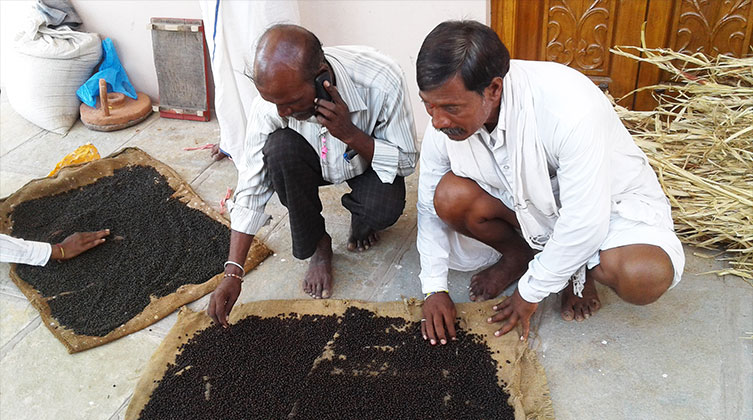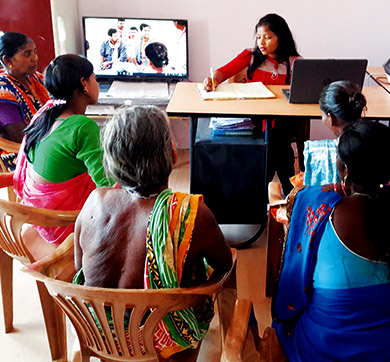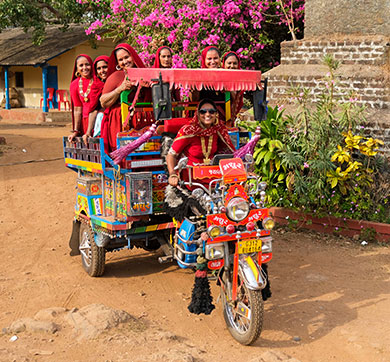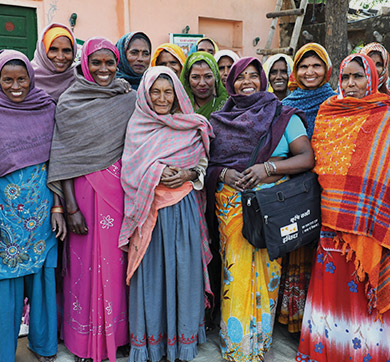March 2021 | 1633 words | 6-minute read
Kushan Baskey has fixed a new roof for his modest dwelling and he isn’t inclined to stop there. The 35-year-old tribal from Patna village in Odisha’s Keonjhar district is looking to build a “concrete-roof house with four rooms”. Additional income in hand means he can look ahead to that and more.
Growing chillies and rearing goats have fetched the five-member Baskey family an additional Rs 96,000 in the past year. It’s a precious gain for Mr Kushan, a subsistence farmer till recently. Now he rides a new motorbike, thinks of setting aside money for his children’s education and is sure he can improve his lot further still.
Fellow-villagers Galuram Baskey and Pithoram Baskey — it’s common for tribal communities to share a surname — have trodden a similar pathway to a better life. Mr Galuram pulled in Rs 85,000 over the year while Mr Pithoram did best of the three, securing an income increase of Rs 142,000.

Adding it all up
Mr Kushan and his mates are part of Lakhpati Kisan (or Rs 100,000 farmer), the centrepiece of a clutch of livelihood improvement programmes undertaken by the Tata Trusts across India. The programmes have reached over a million people in 8,959 villages in 21 states across India. The dominant theme is ‘agriculture and allied activities’, still the mainstay of the country’s rural economy, and it covers farming and much more: animal husbandry, dairy development, fisheries and non-timber forest produce.
This agriculture-plus approach is calibrated to boost the ability of rural and tribal communities to extract more from what is available by way of land and local conditions. Advancing the rural livelihoods cause, especially for women and people from scheduled castes and tribes, is the overall objective and it begins with organising village communities and providing them with access to capital and a spectrum of services.
Implemented by Tata Trusts’ associate organisation Collectives for Integrated Livelihood Initiatives, Lakhpati Kisan — with 104,000 households from 821 tribal villages in Jharkhand, Maharashtra, Gujarat and Odisha within its fold — stands out among the programmes targeted at realising the livelihoods goal. From possibility to premise, Lakhpati Kisan has blossomed to stay true to its name, which is about getting previously marginalised rural farmers past the Rs 100,000 a year in earnings’ mark.
More than 40,000 rural families have breached the Rs 100,000 barrier since the initiative was launched in 2015, lifted irreversibly out of poverty and with a solid foundation to aim higher. The road is well mapped: align everything with agriculture, create robust and resilient village-based organisations — self-help groups (SHGs) and their aggregates — introduce fruitful new farming methods and technology, add animal husbandry, fisheries or other projects that fit the mix, seed entrepreneurs and training programmes, link the produce to markets, and tap governmental support and resources.
Akin to Lakhpati Kisan is the effort by Kalike, a Tata Trusts associate organisation in Karnataka’s Yadgir district. Kalike is involved in a range of projects, from education and skilling to livelihoods and water and sanitation. In livelihoods, the focus is on agriculture, the primary source of income for 67% of the local workforce.
Productivity, income and healthy farmer institutions form the lens through which Kalike sees its projects. This informs the adoption and sharing of best practices, collaborations with government institutions, optimal water usage methods, credit and marketing support, and the promotion of technology.

Women first
“Purchasing some land, educating my children further, investing in equipment — I have been able to do all of that after joining the project,” says Hampayya Sadiri, a farmer from Allipur village who has prospered since shifting to the cultivation of green gram, groundnuts and fruits. “I was confused about the technology initially but there was guidance and I learned.”
The learning curve has proved valuable for the Tata Trusts’ piggery project in the Northeast and for their fisheries and dairy development initiatives as well. Run by the North East Initiative Development Agency, another associate entity of the Trusts, the piggery venture addresses the entire value chain of the enterprise: breeding and feeding, sty hygiene, veterinary services, training and marketing. Nearly 12,500 households in 259 villages of the region have benefitted from the project.
The dairy development effort is spearheaded by the Dairy Health and Nutrition Initiative India Foundation (DHANII), which comes under the Tata Dairy Mission, set up in 2016 to be an enabler for milk producers by providing varied livestock services. Through DHANII, five milk producer companies have been established — two in Rajasthan and one each in Uttar Pradesh, Maharashtra and Punjab — and they together comprise about 46,700 members in 918 villages.
The inland fisheries programme has helped in excess of 35,000 families in six states, and there’s more in it than fish. Besides culture fisheries in public water bodies and fish farming in individually owned ponds, the project backs allied activities that offer additional livelihood opportunities to the farmers involved: fish-breeding nurseries, pond-based horticulture, the growing of vegetables and fruits on embankments, and the rearing of poultry.
Women’s groups, as ever, are the fulcrum of an endeavour that has delivered where it counts. Taken together, the programmes of the Tata Trusts in the livelihoods sphere have reached close to 9,000 villages in 21 states of India. The vast majority of people being lent a hand are small and marginal farmers, many of them previously living below the defined poverty line for rural India (pegged at an income of Rs 1,059 a month). Choreographing the conditions necessary to bring extra income to these folks, without disturbing their social and cultural equilibrium, is a complicated task.

Technology, tinkered and tailored
Technology is the understated ingredient in the blend of elements the Tata Trusts have used across the board in their livelihood programmes, be it in agriculture, dairy development, livestock management or fisheries.
Drip irrigation, solar-powered pumps, water decomposers, interactive voice response services and small-scale mechanisation — technological inputs have been crucial in optimising outcomes in the Trusts’ livelihood interventions. The intent is not to chase after technology but, rather, to obtain the most effective at the lowest cost.
“We decided right at the beginning that we needed to be innovative and not stereotypical,” says Ganesh Neelam, zonal manager for central and east India with the Trusts. “Our eye was on new technologies that would aid small landholders. We want our beneficiaries to understand how a particular technology works and how to integrate it.”
With farm mechanisation, it has been a pointed approach. “Small landholders don’t need big tractors and big harvesters,” adds Mr Neelam. “We went for small mechanisation that suits the farming plots we deal with. These are fragmented, so you need equipment that can move in tiny pockets. We were not sure our farmers would opt for such technologies but they surprised us with their ready acceptance.”
A clean and reliable source of energy was another important requirement. Solar power has provided just that. “Regular electricity supply is an issue in most of the places where our livelihood projects are being implemented; solar is an appropriate solution in the circumstances, and it is clean,” says Mr Neelam. “We are also promoting biogas technology for clean cooking, the advantage being that the slurry discharged in the process is a very good fertiliser.”
Big basket of offerings
“We go and understand the situation on the ground and then engage with families to improve their methods, be it with agriculture or allied livelihoods,” says Ganesh Neelam, zonal manager for central and east India with the Trusts. “Once we are able to understand the gaps, we try building the capacity of the farmers and exposing them to superior processes and technologies. The rest follows: better practices, better seeds and fertilisers, better marketing. It’s handholding and facilitation support that we provide.”

Mr Neelam is clear about what really matters when the results are tallied. “It comes down, ultimately, to food security and a steady, growing income,” he says. “About 90% of the households we start with are in the below-poverty line category. Most of them used to make Rs 35,000 or less a year from agriculture and related activities. We concentrate on ways to enhance this amount three-four times over a fixed period.”
Convincing communities steeped in traditional ways and suspicious of the new and untested is the first and foremost challenge in making that happen. “It’s difficult to persuade villagers to accept change,” adds Mr Neelam. “We work with women and leaders within the villages; we try and engage them in the initiative. Others are then inclined to follow and that’s how we expand the project’s reach and move towards making it sustainable.”
Sustainability comes from having integrated options and, in the longer term, through collaborations. The Trusts actively promote and pursue partnerships with government bodies and donor agencies. A persistent pinprick is the serious shortage of credit support from financial institutions, a reality Mr Neelam bemoans.
The sustainability question attached to the programmes has been answered in the places where community institutions are thriving. “Our learning has been that women-led village organisations and high-quality services, ideally provided by local entrepreneurs, are fundamental to any such livelihood initiative,” says Mr Neelam. “We have exited from villages and they have managed the show by themselves. That’s encouraging.”
The agriculture-and-more mode — livelihoods layering, as it is termed — done correctly and persisted with, can provide for a rural family of five-six members, believes Mr Neelam. “What we ensure is that they have the necessary support systems, guidance and assets. These villagers don’t always have to migrate.”
—Philip Chacko
Source: Tata Trusts' Horizons, December 2020 issue



